Black Walnut Tree: Leaves, Bark (Pictures) – Identification and Care
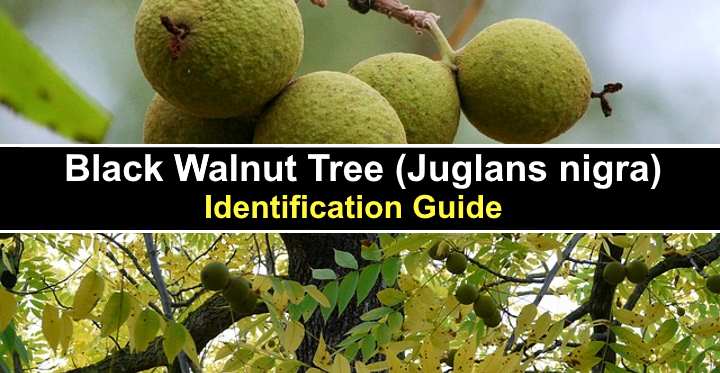
The black walnut tree is a huge deciduous tree with aromatic lanceolate leaves, drooping clusters of greenish-yellow flowers, dark gray bark, and tasty walnuts. Known for its ornamental value, a black walnut tree has an attractive oval crown with upward spreading branches and dense foliage. Apart from being a beautiful tree, the black walnut is usually planted for its abundance of edible nuts.
This article is a complete guide to the black walnut tree. Descriptions and pictures of the tree’s identifying features — its flowers, leaves, bark, and fruit — will help you spot a black walnut in the landscape.
What Does a Black Walnut Tree Look Like?
Black walnut (Juglans nigra) is an ornamental tree in the walnut family Juglandaceae. The enormous tree is identified by its irregular oval crown, pinnately compound leaves, dangling catkins, and clusters of edible nuts. Black walnut trees grow between 100 and 130 ft. (30 – 40 m) and up to 70 ft. (21 m) wide.
A distinctive feature of a black walnut tree is its spicy aromatic scents. The tree leaves, stems, and nut husks emit a pungent odor when crushed. However, the delicious walnuts lack the pungency of the rest of the tree.
Black Walnut Tree Facts
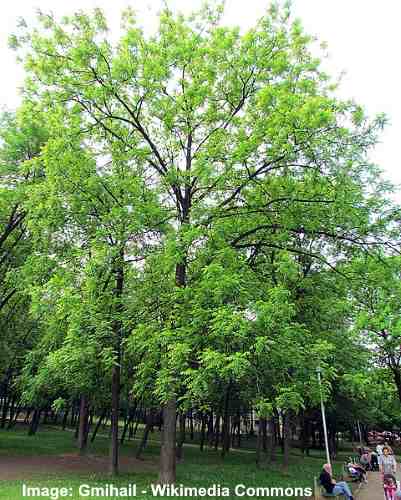
Black walnut tree (Juglans nigra)
Also called the eastern American black walnut, the tree thrives in USDA zones 4 through 9. For best nut production, a black walnut should be planted in full sun where it can grow in organically rich, well-drained moist soil. Once established, the walnut tree is tolerant of drought and can cope with occasional flooding.
Under ideal conditions, black walnut trees have a medium growth rate. In full sun and moist loamy soil, the tree will grow two to three feet (0.6 – 1 m) per year.
One common issue when growing a black walnut tree is a chemical compound called juglone. This substance inhibits the growth of other plants within the tree’s drip line. Even after removing the tree, juglone can stay in the soil and prevent other plants from thriving there.
Black walnut trees have many uses in a landscape, and the tree nuts are used in making cookies, pies, ice cream, and cakes. Timber from black walnut trees is also popular for making top-end furniture, flooring, paddles, and gun stocks. Black walnuts also produce a sugary sap like maple syrup.
Are Black Walnuts Edible?
Nuts from the black walnut tree are delicious and tasty. The edible walnuts have a robust, earthy taste with a distinctive bold flavor. The rich flavor of black walnuts adds a unique taste and texture to baked goods, and the nuts go well with entrees and side dishes.
The distinctive smoky taste of black walnuts is what differentiates it from regular types of walnut trees.
Black Walnut Leaves
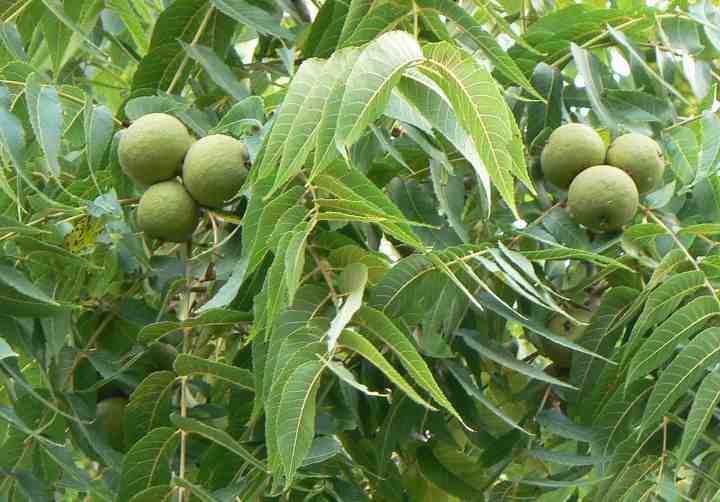
Black walnut leaves and fruit
Black walnut trees have pinnately compound leaves, consisting of 15 to 23 slender lance-shaped leaflets. Each leaflet measures 2 to 4 inches (5 – 10 cm) in length, featuring fine serration along the margins. The entire compound leaf can reach a size of 12 to 24 inches (30 – 60 cm).
A characteristic feature of black walnut growth is that the leaves spend a relatively short time on the tree. Typically, the leaves appear late in the season and drop early in the fall. The fall color of black walnut foliage is golden yellow.
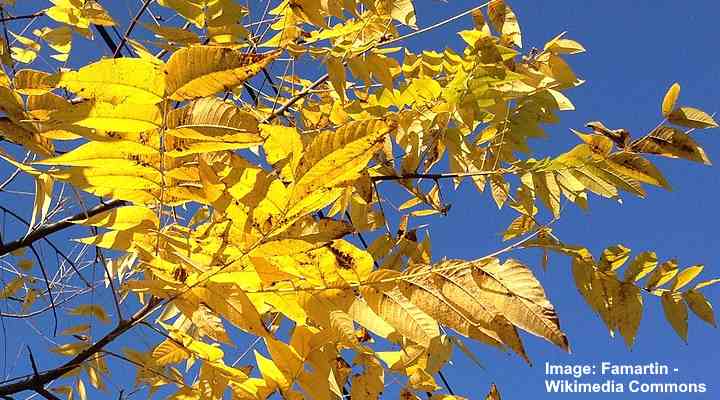
Black walnut leaves in autumn
Black Walnut Tree Bark
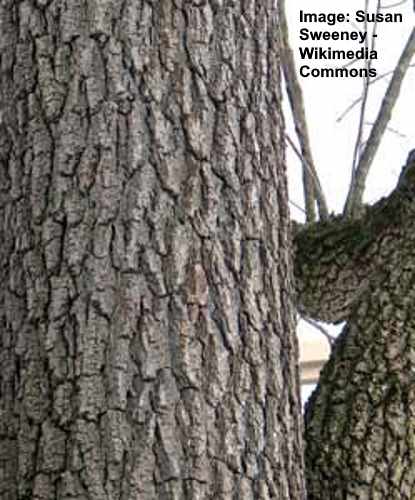
Black walnut tree bark
An identifying feature of a black walnut tree is its thick, dark gray-black bark that develops deep furrows and thin ridges. Looking at pictures of black walnut bark, you’ll notice a distinct diamond-shaped patterning running up the tree trunk.
Stems, branches, and twigs on a black walnut tree are a coppery-brown to black color. One characteristic of black walnut trees is the V-shaped leaf scar with a bud inside it.
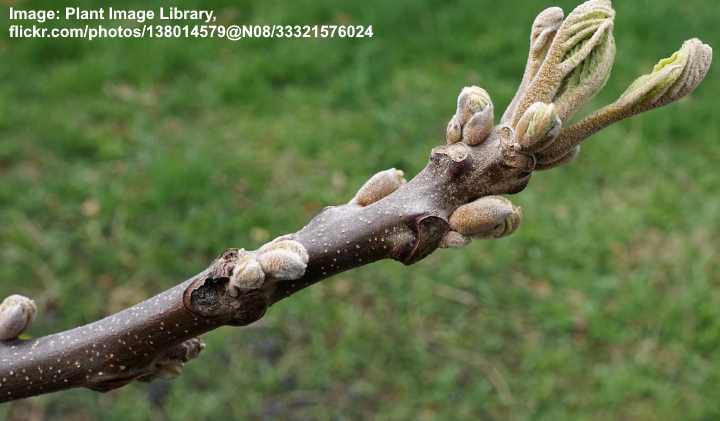
Black walnut twig
Black Walnut Flowers
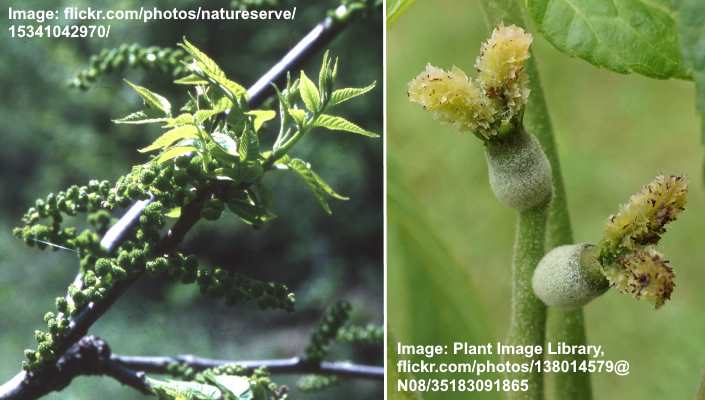
Black walnut male flowers (left) and female flowers (right)
Flowers on black walnut trees are clusters of cylindrical golden yellow or green flowers called catkins. The walnut tree blooms in late May and produces male and female flowers on one tree. Male black walnut flowers are greenish drooping catkins 3” to 4” (8 – 10 cm) long. Female flowers are small greenish clusters.
Black Walnut Fruit
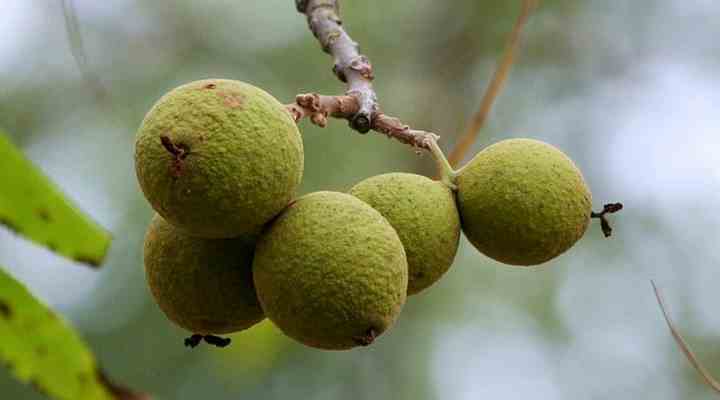
Black walnut fruit
Fruit from black walnut are drupes that look like clusters of round green plums growing on branches. Each globular walnut fruit measures between 1” and 3” across (2.5 – 7.5 cm), and its thick green husk contains a brown to black nut. A trait of black walnut fruit is the yellowish-green husk that stains clothing.
Black Walnut Nut
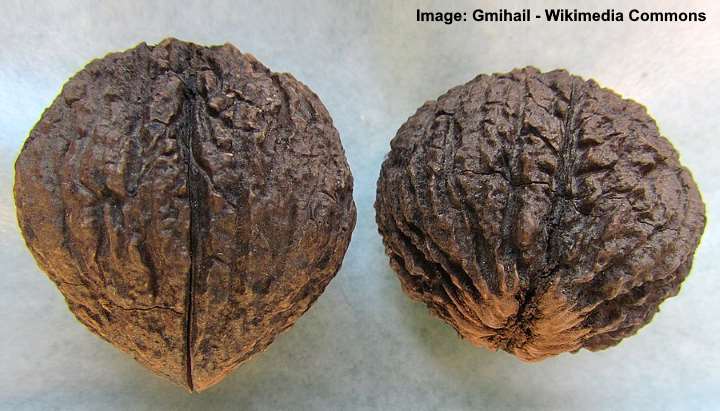
Black walnut nuts
Black walnut nuts are notoriously challenging to get out of their hard brown shells. The delicious walnuts are encased in a tough ball-like outer shell with corrugated ridges. Inside the shell is a fleshy walnut seed. The nuts mature on the tree and are ready for harvesting in the fall.
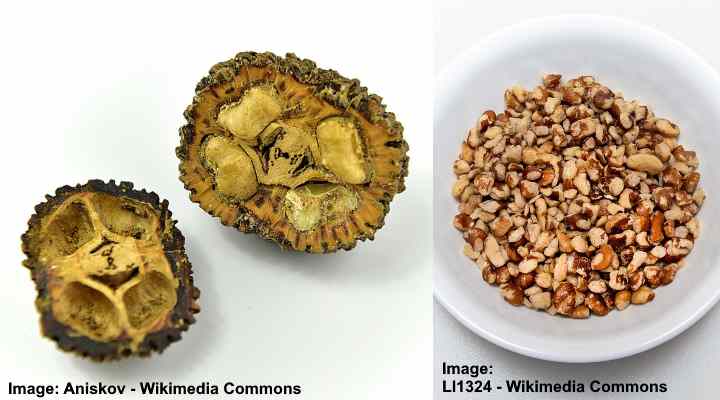
Black walnut kernels
Black Walnut Tree Identification
A black walnut tree is identified by its irregular oval crown, large pinnately compound green leaves, dark gray furrowed bark, and large green globose fruit clusters. A black walnut tree is easy to spot in the fall because of the masses of nuts under the tree.
You can also identify a black walnut tree by looking closely at the twigs. When the leaves drop, you will see a distinctive three-lobed scar that looks like a shamrock on the branch. Additionally, there will be few, if any, shrubs or small trees growing near a black walnut tree.
How to Harvest Black Walnuts
To get ready to collect the nuts, put on protective gloves to protect your skin from the inky substance in the husks. Then look for globose green fruits about 2” (5 cm) in diameter. When ready for picking, the green husk should retain a dent when you press it with your finger.
There are several problems if you wait to collect walnuts too long. First, husks that have turned completely black could contain bitter or rancid-tasting nuts. Second, tasty black walnuts are popular with wildlife, and squirrels and other animals will quickly gather the best nuts.
All black walnuts are harvested from trees growing in the wild. Harvest time is late September through October. On the other hand, most walnuts for sale in stores are from cultivated English walnut (Juglans regia) trees.
How to Process Black Walnuts to Eat Their Nut
When processing black walnuts to eat, always wear protective clothing. First, you will need a hammer or strong knife to remove the hulls. Some people cover the collected walnuts with a tarp and drive over them to de-hull them. After removing the hulls, thoroughly wash the nuts and discard any that float.
The next step to process black walnuts for consumption is to dry them. Next, lay them out in a single layer to dry for two to four weeks. Then, put them in a well-ventilated area, away from direct sunlight. Also, make sure that squirrels can’t get to them.
Drying and curing unshelled black walnuts make them easier to crack open.
If you keep them in a cool, dry place, you can store unshelled walnuts in burlap sacks or baskets for up to one year.
Where to Plant Black Walnut Tree
The best place to plant a black walnut tree is in full sun, well-drained land. Ideally, the black walnut tree thrives in deep, fertile loamy soil that holds moisture without becoming soggy. Ensure that your location has at least 140 frost-free days annually for the tree to thrive.
Another consideration when choosing where to plant a black walnut tree sapling or rooted plant is other plants. The tree’s roots contain juglone and can be toxic to some types of shrubs and trees. Therefore, don’t grow plants or fruit trees within 70 ft. (15 m) of black walnut.
How to Grow Black Walnut Tree From Seed
Black walnut trees are easy to grow from seed. The key to germinating a black walnut seed is exposing them to cold temperatures and moist conditions. Alternatively, you can stratify them indoors to help the walnut seeds sprout.
You can plant black walnut seeds directly in the ground in the fall. Choose a suitable location and plant one seed about 2” (5 cm) deep in the soil. They should germinate the following spring. However, you must protect the seeds in the ground from squirrels and other wildlife.
To stratify seeds indoors, place the dried seeds in a bag containing moist peat moss and sand. Then, put the seeds in the refrigerator for three to four months. After the stratifying process, you can plant seeds in a pot or your garden in the spring.
How to Grow Black Walnut Tree in a Container
To grow a black walnut tree in a pot, choose one that is 20” wide and 18” deep (50 x 45 cm). It should have drainage holes. Fill the pot with a mixture of peat moss and potting soil, amended with perlite for drainage. Plant the walnut seed about 2” (5 cm) deep with the nut on its side and water well.
It is vital to protect the seed and sapling from wildlife. Therefore, cover the pot with wire mesh. Only water the container when the top 2” (5 cm) of soil is dry. When the walnut sapling is about 1 ft. (30 cm) high, you can transplant it to the ground in early spring.
Alternatively, you can continue to grow the black walnut in a container if you have a compact garden or container garden. However, be aware of allelopathy — the process where juglone can affect the growth of other plants if drainage water seeps into the ground.
Planting a Black Walnut Tree in the Ground
After choosing a sunny location, dig a hole twice the width of the root system and the same depth. You will notice that it has a large taproot like a carrot. Plant the rooted tree at the same depth as it has grown in the container.
Backfill the hole with compost-rich soil, pressing down as you go to remove air pockets. After filling in the hole, thoroughly water it to irrigate the roots. Lastly, add a thick layer of mulch to help keep the soil moist and prevent weeds from growing.
Black Walnut Tree Care
Walnut trees are relatively easy to care for in a garden landscape. The tree should thrive as long as a black walnut gets at least six to eight hours of sunlight and is sheltered from strong winds.
Here are some helpful tips on caring for a black walnut tree.
How to Water Black Walnut Tree
A black walnut tree requires consistently moist soil during the growing season to thrive. The walnut tree needs around 1” (2.5 cm) of water per week during spring and fall. In the summer months, double the amount of water it gets. From late fall until the end of winter, rainfall should provide enough irrigation.
Black Walnut Tree Fertilization
Fertilizing a black walnut tree twice a year encourages leafy growth and plenty of nuts.
In spring, use a nitrogen-rich tree fertilizer with an NPK rating of 21-0-0. You should apply this to the root area, leaving a gap of 24” (60 cm) in diameter around the trunk free.
In summer, you should use a balanced organic fertilizer for trees to encourage good growth. For example, apply a tree fertilizer with an NPK rating of 15-15-15 in June. Always follow the manufacturer’s instructions.
How to Prune Black Walnut Tree
Pruning a black walnut tree is vital for its healthy growth. When the tree is young, trim back branches in late winter by removing 3” to 4” (7.5 – 10 cm). Then, repeat the pruning process in July.
Once the black walnut tree grows taller, you can remove branches below 4 or 5 ft. (1.2 – 1.5 m) on the central trunk. This allows branches to grow strong and also assists with harvesting nuts.
As annual maintenance, you should always remove dead, diseased, or crossed-over branches. The best time to prune a black walnut is in late winter or early spring before the tree comes into leaf.
Propagating Black Walnut Tree
You can propagate a black walnut tree by taking soft twig cuttings from a healthy tree in late winter or early spring. Choose a twig that has numerous leaf buds. Cut a 10-inch (25 cm) section of stem that is no more than 2” (5 cm) thick. Then remove a 1” (2.5 cm) length of bark from the cut end.
Put the black walnut tree cutting in a 1-gallon (3.7 l) pot filled with potting soil. Plant the cutting about 5” (13 cm) deep and firm the soil around the twig. It should take about four months for a black walnut cutting to root. You can then transfer the immature tree to its permanent location.
Pests Affecting Black Walnut Tree Growth
Although the black walnut is relatively resistant to pests, caterpillars, shoot borers, beetles, and aphids can affect its growth. Pest infestations can result in tree cankers, damaged leaves, or a lack of viable nuts. Here is a short overview of black walnut tree pests:
Walnut caterpillar (Datana integerrima) is a brown or black hairy caterpillar that can defoliate walnut and hickory tree leaves. The caterpillars emerge in late spring and early summer. Using Bacillus thuringiensis is helpful for controlling the larvae.
Walnut shoot moth (Acrobasis demotella) is a destructive borer that lays eggs under walnut tree leaves. The emerging larvae feed on leaves and can cause shoot dieback.
Walnut twig beetle (Pityophthorus juglandis) is an invasive pest that spreads thousand cankers disease to black walnut trees. This fungal pathogen causes cankers to appear on the tree and eventually death.
Diseases Affecting Black Walnut Tree Growth
Apart from thousand cankers disease, other foliar and root diseases can affect a black walnut’s growth.
Walnut anthracnose (Gnomonia leptostyla) is a foliar fungal infection that can cause brown or black spots on black walnut leaves. This disease can cause premature leaf drop and disfigured tasteless nuts. To prevent further infection, rake up and destroy all affected leaves and apply a high-nitrogen fertilizer in spring.
Powdery mildew (Phyllactinia guttata) looks like leaves have a dusting of white flour. The fungal leaf infection is caused by damp conditions or inadequate airflow. In addition, new leaves may wither and fail to mature properly. To prevent powdery mildew on black walnut trees, prune the branches to increase air circulation.
Walnut blight (Xanthomonas campestris) is a bacterial infection that causes unsightly dark brown and black patches on black walnut tree leaves. The disease can affect nut production.
Related articles:
